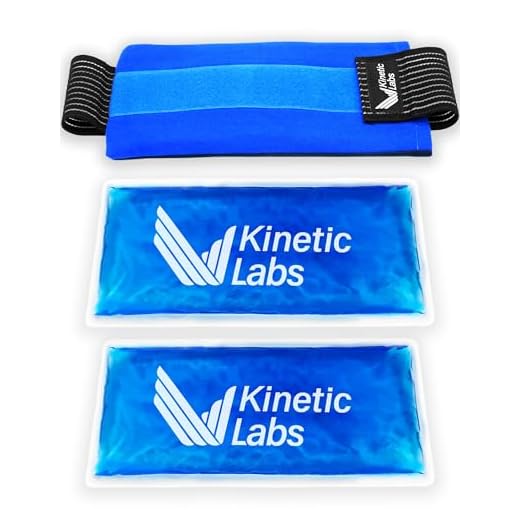




Applying cold compresses can significantly aid in reducing swelling and alleviating pain in your furry friend. Whether it’s a sprain, strain, or post-surgery discomfort, these chilled solutions work wonders. It’s vital to wrap the compress in a cloth to prevent direct contact with the skin, as this can lead to frostbite. Limit the application to around 10-15 minutes at a time, allowing intervals to prevent any adverse reactions.
In my experience, my dog once sprained her paw during a spirited game of fetch. After consulting my vet, I learned the importance of immediate care. A cold compress not only helped with the swelling but also calmed her down. Watching her relax while I gently held the compress in place was rewarding. Always monitor your pet’s reaction; if they seem uncomfortable or overly sensitive, discontinue use and consult a professional.
Timing is crucial. The sooner you can apply a cold solution after an injury, the better the outcome. Keep a few gel packs in the freezer specifically for your pet’s needs. This way, when accidents happen, you’re prepared. Remember, while these compresses can provide relief, they’re not a substitute for veterinary care when needed.
When is it safe to use ice packs on dogs?
Applying cold compresses is suitable after intense physical activity or following a minor injury. If your furry friend has been running around at the park and seems a bit sore, this can provide relief. However, avoid using them on areas with open wounds or severe swelling without veterinary guidance.
Always test the temperature before application. A cold surface should feel cool, not freezing. Wrap the compress in a cloth to prevent direct contact with the skin, which can cause frostbite. Use for short intervals, about 10-15 minutes, and allow the skin to return to normal temperature between applications.
In cases of heat stress, a cold compress may help cool down your pet, particularly on the neck, armpits, and groin. Monitor your dog closely during this process to ensure they are responding positively.
If symptoms persist or worsen, consulting a veterinarian is advisable. They can provide tailored advice based on your pet’s specific needs. Always prioritise your companion’s comfort and health above all else.
How to properly apply ice packs to your dog’s body?
Begin with a thin cloth or towel to wrap the cooling compress. This barrier protects the skin from direct contact and prevents frostbite. Make sure the material is clean and soft to avoid irritation.
Identify the affected area; common spots include joints, muscles, or areas with swelling. Gently place the wrapped compress on the targeted section, ensuring it fits comfortably without pressure.
Limit exposure to 15-20 minutes at a time. This duration helps in reducing swelling while protecting the skin from cold damage. Monitor your pet closely for any signs of discomfort.
Repeat the application every few hours as needed. Allow the skin to return to normal temperature between sessions for safety. Hydration is crucial, so ensure fresh water is available.
- Monitor your pet’s behaviour; if they show signs of distress, remove the compress immediately.
- After treatment, observe the area for any changes in swelling or redness.
- Consult a veterinarian if you notice persistent issues or if swelling worsens.
Using these steps can provide relief, helping your furry companion feel more comfortable during recovery. Always prioritise their well-being throughout the process.
What types of ice packs are suitable for pets?
For cooling purposes, gel-based compresses are preferred. They conform well to the body shape and provide even cooling without being too rigid. Look for those specifically designed for animals, as they usually have pet-safe materials.
Reusable cold packs are another option. These often come in various sizes and shapes, making them versatile for application on different body areas. Ensure the outer layer is soft and non-slip for comfort and stability.
Homemade options, like a bag of frozen vegetables wrapped in a towel, can work in a pinch. Just make sure the bag isn’t too heavy or hard, and always monitor the temperature to avoid frostbite.
Consider using instant cold packs, which activate with a squeeze. These are convenient for travel or emergencies. However, confirm that the contents are non-toxic and safe for your furry friend.
Whichever type is chosen, always assess the comfort level and reaction of the animal during use. It’s crucial to keep an eye on the duration of application to prevent any adverse effects.
Signs that Indicate Your Dog Needs Veterinary Attention After Using Ice Packs
Watch for excessive shivering or trembling. If your pet can’t seem to warm up or appears unusually anxious, it may indicate discomfort or a negative reaction to the cold treatment.
Monitor for skin irritation or damage. Redness, swelling, or blistering at the application site is a clear sign that the temperature was too low or the duration too long. It’s crucial to stop using the cold compress and consult a vet.
If your furry friend exhibits signs of lethargy or unresponsiveness, it may be a sign of underlying issues exacerbated by the cooling method. Pay attention to any changes in behaviour, such as reluctance to move or play.
Increased panting or signs of distress should not be overlooked. If your companion seems to have difficulty breathing or is vocalising discomfort, seek professional advice immediately.
Changes in appetite or drinking habits can also signify that something isn’t right. If your pet refuses food or water after treatment, especially if they are usually enthusiastic about meal times, consider reaching out to a veterinarian.
Finally, if you notice swelling or warmth around joints or muscles that were treated, it may be a sign of an adverse reaction. Contact your vet for a thorough examination to rule out any serious conditions.
For those who may wonder about canine quirks, check out this link: why will my dog only eat food off the floor.






